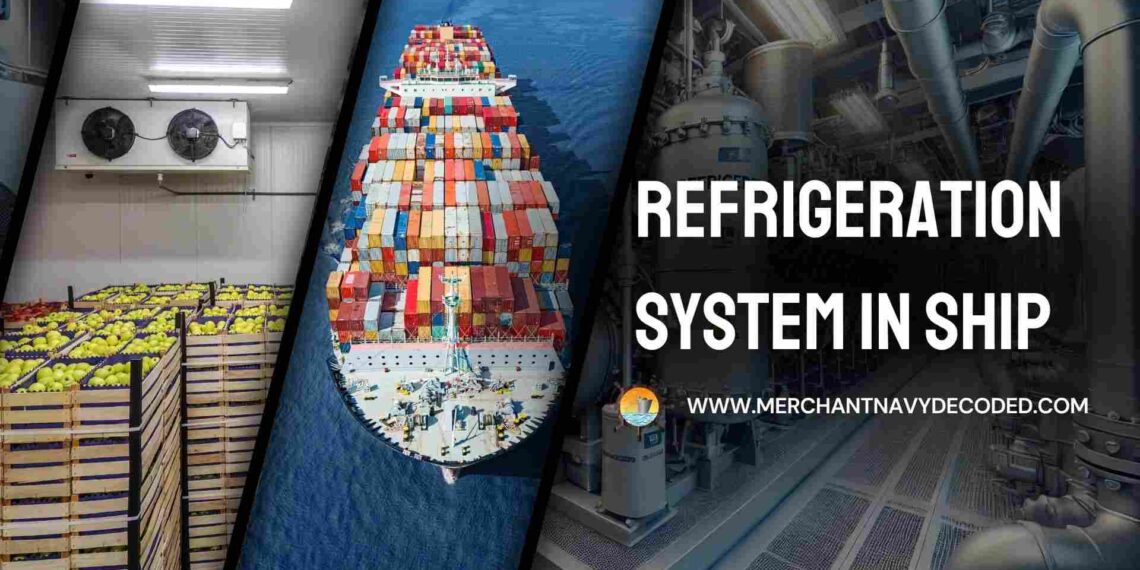Refrigeration System in Ship | Working and Regulations
Table of contents
- 1:- Overview
- 2:- Working of Refrigerator in Ship
- 3:- Regulations for Refrigeration System in Ship
- 4:- Procedure for Charging Refrigeration System in Ship
- 5:- Safety Precautions in Ship’s Refrigeration System:
- 6:- Various Types of Refrigerants Used in Ship’s Refrigeration System:
- 7:- What is Refrigerant Recovery?
- 8:- What is Refrigerant Recycling?
- 9:- Importance of Refrigerant Recovery and Recycling
1:- Overview
This is a detailed series of blogs on refrigeration, including the refrigeration cycle, refrigerants used on board, regulations affecting the changes in the refrigeration system and procedure, preparation, and precautions while charging the refrigerants.
2:- Working of Refrigerator in Ship
There are four different processes involved in the main components of a refrigeration system.
- In compressor–isentropic compression
- In evaporator – Isobaric heat rejection/ condensation
- In the thermostatic expansion valve – Isenthalpic expansion
- In evaporator – Isobaric heat absorption
- Compressor: The system’s heart is the compressor, which takes in the refrigerant vapor of low pressure and temperature from the evaporator and compresses it into a high-pressure, high-temperature vapor.
- Condenser: Into the condenser flows the hot high-pressure vapor that gives off heat to a cooling medium (usually seawater), thereby causing it to condense into a high-pressure liquid.
- Receiver: A reservoir called the receiver stores the high-pressure liquid refrigerant to ensure a steady supply of it to the expansion valve.
- Expansion Valve: The flow of liquid refrigerant into the evaporator is controlled by an expansion valve also known as a metering device. This reduces the temperature of refrigerant and reduces its pressure causing it to expand and thus turn into a gas.
- Evaporator: Low-pressure, low-temperature refrigerant vapor enters an evaporator where it absorbs heat from surrounding space like cargo hold or food storage. As a result, all the remaining refrigerant completely evaporates while turning back into low-pressure vapors and then returns for another cycle.
For more details on the refrigeration system onboard you can CLICK HERE.
3:- Regulations for Refrigeration System in Ship
Refrigeration systems on ships are governed by numerous international and national regulations to ensure safety, environmental protection, and compliance. Notably among them include:
- MARPOL Annex VI: This is an Annex of the International Convention for the Prevention of Pollution from Ships (MARPOL) which as discussed earlier on air pollution prevention includes rules for ozone-depleting substances used in refrigeration.
- International Code for Refrigerated Ships (ICRS): The code gives guidelines for the design, construction, and operation of refrigerated ships including requirements concerning refrigeration plants insulation and safety measures.
- Flag State Regulations: Every ship’s flag state (the country where a ship is registered) may have its additional regulations specifically related to refrigeration systems.
- Classification Society Rules: Refrigerant plant rules are regulated by classification societies; they are companies that provide technical oversight as well as certification to ships.
4:- Procedure for Charging Refrigeration System in Ship
The charging procedure can differ slightly depending on the refrigerant type and the specific system design. However, in general, these are the stages:
4.1:- Preparation and Safety of Ship Refrigeration System
- Personal Protective Equipment (PPE): Always observe PPE requirements such as wearing safety goggles, gloves, and protective clothing.
- Ventilation: Ensure proper ventilation of the area to avoid refrigerant vapor accumulation.
- System Isolation: Separate it from other machinery that belongs to a ship so as not to cause any accidental action while being charged.
- Leak Check: Carry out a detailed leak check across all parts of the system using either a gas or soap solution leak detector and fix any leakage before you proceed.
- Evacuation: Remove air and moisture within the system with the use of a vacuum pump. This is very crucial since contaminated systems do not run properly when recharged.
4.2:- Connection and Measurement of Refrigeration System in Ship:
- Manifold Gauge Set: Connect a manifold gauge set with high-pressure service port or low-pressure service port of the system. These allow you to monitor pressures during charging.
- Refrigerant Cylinder: Use a charging hose to connect the refrigerant cylinder to the manifold by ensuring that the cylinder valve is blocked off.
4.3:- Charging Process for Refrigeration System on Ship:
- Weights Charging: The majority of on-board ship systems require the use of weight charging. We could measure the weight of the refrigerant cylinder before and after recharging.
- Vapor or Liquid Charging: Depending on the type of refrigerant and design of a system, charging can be done in vapor form through the low-pressure side or liquid form through the high-pressure side. Consult the system’s manual to find out.
- Gradual Charging: Slowly open the cylinder valve and allow refrigerant to enter the system gradually while watching the pressure gauges.
- Target Pressures: For proper target pressures (suction and discharge) on an operating temperature, reference to the system’s specifications is required.
4.4:- Verification And Adjustment of Refrigeration System in Ship:
- Leak Check: After charging, make another leak check to ensure that no leaks have resulted from it.
- System Operation: Switch on for some time monitoring pressures, temperatures, and overall performance
- Refrigerant Charge Adjustment: If it’s not up to spec adjust refrigerant charge whatever it takes This may involve incrementing or decrementing minute amounts of refrigerant.
5:- Safety Precautions in Ship’s Refrigeration System:
- Always stick to safety guides and instructions as stated by the manufacturer of a product.
- Proper personal protective equipment and tools should be used.
- Be aware of the hazards associated with a specific type of refrigerant being employed.
- Never mix different types of refrigerants.
- Dispose of used refrigerants and containers properly.
- Recuperation of Refrigerant.
6:- Various Types of Refrigerants Used in Ship’s Refrigeration System:
- Chlorofluorocarbons (CFCs): cooler systems for marine applications were mainly based on refrigerants like R-115, R-12, and R-11 because of their excellent cooling ability. However, these substances are not allowed in the new installations due to high Ozone Depletion Potential (ODP) ratings. The use and service of CFCs is controlled with existing systems.
- Hydrochlorofluorocarbons (HCFCs): HCFCs such as R-123, R22, and R124 served as transitional substitutes for CFCs. They still have ODP values lower than that of CFCs but contribute to ozone depletion. Ships built on or after January 1st, 2020 are prohibited from being fitted with new systems using HCFCs.
- R-12: Though it was non-flammable and had other good attributes, it became a popular choice in the past. It is banned in new installations since it’s a CFC with one of the highest ODP values. Existing ships that have r-12 equipment may experience challenges when trying to maintain them or replace them eventually.
- R-22: This was once used as a drop-in replacement for r-12 however; its use has been declining because of phasing out regulations. Careful management of old r22 units will be needed before they can finally be converted to other alternative refrigerants.
- R-134a: R-134a is a popular HFC due to having no ODP. It has a relatively high GWP and is, therefore, still a climate changer. It is still in use in a few marine applications, but the industry is researching alternatives with lower GWP.
- R-407C: A blend of HFCs, which has been used on some marine refrigeration systems because of the low ODP and non-flammable characteristics. But like R-134a, it has high GWP, and its use is under reconsideration, like all other refrigerants to find an environmentally sustainable option.
7:- What is Refrigerant Recovery?
Refrigerant recovery is the process of extracting refrigerant from a system, usually during maintenance, repair, or equipment decommissioning. It’s an important step in preventing the release of harmful refrigerants into the atmosphere that can cause ozone depletion and climate change.
7.1:- Methods for Refrigerant Recovery:
There are two primary methods of recovering refrigerants:
- Active Recovery:
- Process: Active recovery involves the use of specific machines (recovery units) to pump out refrigerants from systems and deposit them in a recovery cylinder.
- Advantages: Faster, more efficient than passive recovery, suitable for larger systems, recovers refrigerants even from low-pressure systems.
- Equipment: Requires a dedicated recovery unit and hoses as well as gauges.
- Passive Recovery
- Process: Passive recovery works by utilizing the difference in pressure between the system and the location where it is recovered. High-pressure systems then convey gases to lower-pressure cylinders.
- Advantages: Simpler; often cheaper than active recovery; compatible with smaller units
- Limitations: Slower than active recovery, may not recover all refrigerants present in the system especially when there is low system pressure.
8:- What is Refrigerant Recycling?
Cleaning and purifying recovered refrigerant to get rid of impurities like moisture, oil, and dirt is referred to as refrigerant recycling. This is done to ensure that the refrigerant meets the prescribed purity standards by such organizations as the Air-Conditioning, Heating, and Refrigeration Institute (AHRI).
8.1:- Process of Recycling:
- The oil separator runs over the collected coolant to get rid of any oils present in the system.
- Filtering: Then the coolant has to go through a filter process for it to remove all solid contaminants.
- Dehydration: The coolant has to pass a dehydrator stage which removes every trace of water in it.
- After distillation, it may have some further refining done on it depending on the type of coolant.
9:- Importance of Refrigerant Recovery and Recycling
- Environmental Protection: Prevents release of harmful coolants into the air thus reducing depletion of the ozone layer and emissions leading to the greenhouse effect.
- Resource Conservation: This allows valuable coolants to be reused thereby reducing fresh manufacture quantities required.
- Regulatory Compliance: There are various legislations in many countries and regions requiring the recapture or disposal of coolants.
Disclaimer :- The opinions expressed in this article belong solely to the author and may not necessarily reflect those of Merchant Navy Decoded. We cannot guarantee the accuracy of the information provided and disclaim any responsibility for it. Data and visuals used are sourced from publicly available information and may not be authenticated by any regulatory body. Reviews and comments appearing on our blogs represent the opinions of individuals and do not necessarily reflect the views of Merchant Navy Decoded. We are not responsible for any loss or damage resulting from reliance on these reviews or comments.
Reproduction, copying, sharing, or use of the article or images in any form is strictly prohibited without prior permission from both the author and Merchant Navy Decoded.



